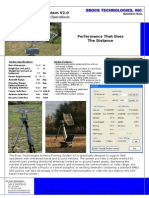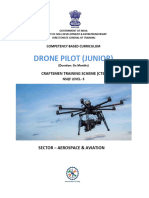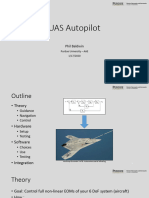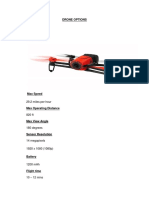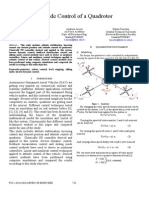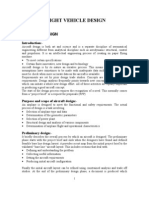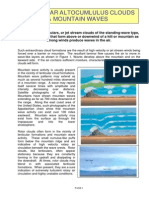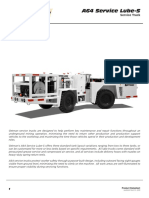Simulation Platform For Quadrotor
Simulation Platform For Quadrotor
Uploaded by
Amira HosnyCopyright:
Available Formats
Simulation Platform For Quadrotor
Simulation Platform For Quadrotor
Uploaded by
Amira HosnyOriginal Description:
Original Title
Copyright
Available Formats
Share this document
Did you find this document useful?
Is this content inappropriate?
Copyright:
Available Formats
Simulation Platform For Quadrotor
Simulation Platform For Quadrotor
Uploaded by
Amira HosnyCopyright:
Available Formats
Page 1 of 2
Simulation Platform for Quadrotor Unmanned Aerial Vehicle
A. Kaviyarasu
, A.Saravanakumar
and K.Senthilkumar
*Research Scholar, Department of Aerospace Engineering, Anna university,Chennai,600044.
Research Scholar, Department of Aerospace Engineering, Anna university,Chennai,600044.
Associate Professor, Department of Aerospace Engineering, Anna university,Chennai,600044.
Presenting authors email: isrokavi@gmail.com
Abstract
This paper proposed the design and development of a simulation platform for simulation quadrotor
unmanned aerial vehicle. The quad rotor UAV model (i.e an Aircraft Flies like a helicopter using its four
motors) has been developed in the X-plane environment and excuted via the matlab/Simulink platform.
The key idea behind the simulation is maintain all of motors in same speed. The attitude of the quarotor
can be controlled via its variable speed of the motors. Here pitch, roll, yaw and throttle is fed as reference
input through the UDP port. The difference between the reference inputs, the simulated outputs are again
fed back to simulator through UDP port and the gains are observed for the responses of quadrotor
unmanned aerial vehicle in Matlab /Simulink environment.
1. Introduction
Nowadays, one of the most interesting topics among the research community is application of Unmanned Aerial
Vehicles (UAV). The operation and development of UAVs has increased during the last few years because of its
unique advantages and applications. There are some difficult situations, which human could not handle, such as
working in steep terrains, military operational areas, natural disasters, rescues, structures inspections, making
geographic maps and small indoor facilities [1, 2]. Such areas have problems of requiring massive equipment to
operate a mission, there needs to be some other solution for those situations. In order to help in such difficult
situations, unmanned aerial vehicles (UAVs) are used and lot of researches are in process in that area. There are
several requirements of UAV in such areas, like less weight, small in size, capability of vertical takeoff and landing,
finally it must have hovering facility. Considering the above requirements a Quadrotor is considered to be a best
solution. Here this paper presents modeling, dynamics and control of Quadrotor The configuration of quad rotor
unmanned aerial vehicle consists of four motors with its propellers. These motors are arranged at the corners of a
plus (+) shaped frame, so each arms of frame will make an angle of 90 degree with one another. Two motors are
rotating in close-wise direction and other two motors rotating in anti-clockwise direction. Each of the propellers will
generate a vertically upward lifting force. The linear and rotational motion of quad rotor can be achieved by
commanding different speeds to different motors, which in turn produces differential aerodynamic forces and
moments. To achieve pitch and longitudinal motion, speeds of motors 1 and 3 have to be changed conversely.
Similarly, for producing roll and lateral motion, speed of motors 2 and 4 is changed conversely. To produce yaw,
the speed of two oppositely-placed motors has to be increased while the speed of the other pair has to be
decreased by same amount. The differential drag moment created by propeller creates a yawing motion [3].
2. Proposed Platform
The main components of the test platforms are as follows.
o Matlab/Simulink containing the autopilot control system.
o Flight Simulator X-Plane containing the quad rotor model to be controlled.
The test platform concept proposed here is based on the block diagram presented in Figure 1. In the test platform,
the block Controller is replaced by the designed autopilot system model and it runs into the Matlab/Simulink
environment. Similarly, the block Quad rotor Dynamics is replaced by the X-Plane flight simulator with the Quad
rotor model that is to be controlled. Thus, the basic principle of the test platform is establishing the communication
Page 2 of 2
between Matlab/Simulink, X-Plane, and microcontroller. The parameters calculated by the autopilot control system
are sent to X-Plane in order to command the Quadrotor Motors M1, M2, M3 and M4. The X-Plane calculates the
new attitude of quadrotor according to the inputs received from Matlab/Simulink. The X-Plane sends those new
quad rotor attitude parameters back to Matlab/Simulink closing the loop. Matlab/Simulink restarts the process by
providing updated commands to X-Plane quadrotor model.
Fig.1 Various Results of Quadrotor Model in X-plane environment
3. Plane Maker Setup
Plane maker is a tool in X-Plane software package which help users to design their custom build aircraft model.
Once all the physical specifications of the airplane have been entered (e.g., weight, propulsion type( Electric
engine), propeller size, Motor Maximum RPM, etc.), the X-Plane simulator will predict how the aircraft flies. Once
the model has been created in the Plane maker environment; it creates an .acf format file. The .acf file is ready to
run the created quad-rotor model in the X-plane environment.
4. X-Plane Setup
X-plane sends data in the form of different sentences, each sentences are divided into 41 bytes of data. The first
four bytes of the packet represents the characters DATA used to indicate data packet. The fifth byte is an internal
code (I). The next four bytes represent the parameter label (L1, L2, L3, and L4). Following 32 bytes (B11, B12,
B13, B14 to B81, B82, B83, B84) represents the data itself in single precision floating point . Taking each of 4
bytes, the first bit is the sign bit. It represent the number is positive or negative. The next 8 bits are biased
exponent, remaining 23 bits represents the mantissa. The rest of the bytes complete the data. So, the
Matlab/Simulink model has to decode this data packet accordingly
5. Matlab/Simulink Setup
The instrumentation and control toolbox in Matlab/Simulink can helps to sending and receiving data from X-plane.
The UDP Receive block in Matlab/Simulink will receive data from the IP Address where the X-plane software is to
be executed. After receiving the data from the IP Address, it unpacks data into an array of bytes. The received
data are in the form of sentence, after decoding it, we can get corresponding decimal data like Speed of every
motors, pitch, roll and yaw of the quadrotor unmanned aerial vehicle. Sending array of bytes (Reference inputs)
from Matlab/Simulink to X-Plane is similar to that of data received from X-Plane. While sending the data to X-plane
make sure that the fifth byte is set to zero
6. References
[1] Gabriel M. Hoffmann , Haomiao Huang , Steven L. Wasl , Er Claire & J. Tomlin, Quadrotor Helicopter Flight
Dynamics and Control Theory and Experimentation, In proc. of the AIAA Guidance, Navig and Control Conf.,
(2007) 1-20.
[2] L. Derafa, A.Benallegue & L.Fridman, Super twisting control algorithm for the attitude tracking of a four rotors
UAV, J Frank Inst 349(2) (2012) 685699.
[3] N.K. Gupta, R. Goel, & N. Ananth krishnan, Design/Development of Mini/Micro Air Vehicles through Modeling
and Simulation: Case of an Autonomous Quadrotor, Def Sci J 61(4) (2011) 337-345.
[4] Jiang Jun, Qi Juntong, Song Dalei & Han Jianda, Control platform design and Experimentation Of a
Quadrotor, in proc of the 32nd Chin control Conf (2013) 2974-2979.
[5] Fernando, De Silva, De Zoysa, Dilshan & Munasinghe, Modeling, Simulation and Implementation Of a
Quadrotor UAV, in proc Int Conf on Ind and Inf Sys (2013) 18-20, (2013), Sri Lanka.
You might also like
- Evaluating The Procurement Strategy Adopted in The Scottish Holyrood Parliament Building Project100% (4)Evaluating The Procurement Strategy Adopted in The Scottish Holyrood Parliament Building Project13 pages
- The Design and Development of A General-Purpose Drone100% (1)The Design and Development of A General-Purpose Drone72 pages
- Worldwide Engineering Standards: GM Global Fastening Catalog100% (1)Worldwide Engineering Standards: GM Global Fastening Catalog107 pages
- Validation of A Quad-Rotor Helicopter Matlab-Simulink and Solidworks Models - ABNo ratings yetValidation of A Quad-Rotor Helicopter Matlab-Simulink and Solidworks Models - AB6 pages
- Simulating Quadrotor UAVs in Outdoor ScenariosNo ratings yetSimulating Quadrotor UAVs in Outdoor Scenarios7 pages
- ME4241 - Aircraft Performance and Stability Course Assignment Stability and Control of Quadcopter DronesNo ratings yetME4241 - Aircraft Performance and Stability Course Assignment Stability and Control of Quadcopter Drones7 pages
- A Vision-Based Automatic Landing Method For Fixed Wing UAVsNo ratings yetA Vision-Based Automatic Landing Method For Fixed Wing UAVs15 pages
- Brock Technologies Antenna Pointing System V2 BrochureNo ratings yetBrock Technologies Antenna Pointing System V2 Brochure1 page
- A Survey of Open-Source UAV Flight Controllers and Flight SimulatorsNo ratings yetA Survey of Open-Source UAV Flight Controllers and Flight Simulators13 pages
- Visual Tracking and Control of A Quadcopter Using PDFNo ratings yetVisual Tracking and Control of A Quadcopter Using PDF8 pages
- The British Gliding Association Manual - Sample100% (1)The British Gliding Association Manual - Sample32 pages
- DJI Phantom3 Standard Preflight Checklist PDFNo ratings yetDJI Phantom3 Standard Preflight Checklist PDF1 page
- Quadcopter Dynamics and Simulation - Andrew GibianskyNo ratings yetQuadcopter Dynamics and Simulation - Andrew Gibiansky24 pages
- Drones Aerial Surveillance McNeal FINAL PDFNo ratings yetDrones Aerial Surveillance McNeal FINAL PDF34 pages
- Drone Types-Multi, Fixed, Single, Hybrid HTTP - Swww.auav - Com.auarticlesdrone-TypesNo ratings yetDrone Types-Multi, Fixed, Single, Hybrid HTTP - Swww.auav - Com.auarticlesdrone-Types13 pages
- Design and Analysis of Fixed Wing Unmanned Aerial VehicleNo ratings yetDesign and Analysis of Fixed Wing Unmanned Aerial Vehicle8 pages
- Wireless Control Quadcopter With Stereo Camera: P.Manoj, S.GokulakannanNo ratings yetWireless Control Quadcopter With Stereo Camera: P.Manoj, S.Gokulakannan24 pages
- Control System Design of An Vtol Fixed-Wing AircraftNo ratings yetControl System Design of An Vtol Fixed-Wing Aircraft4 pages
- A Survey On Open-Source Flight Control Platforms of Unmanned Aerial Vehicle100% (1)A Survey On Open-Source Flight Control Platforms of Unmanned Aerial Vehicle7 pages
- Design and Development of The Hardware For Vision Based UAV AutopilotNo ratings yetDesign and Development of The Hardware For Vision Based UAV Autopilot6 pages
- Multirotor Control - A First Look at Flight Controllers For Quadcopters and Other Unmanned Aerial VehiclesNo ratings yetMultirotor Control - A First Look at Flight Controllers For Quadcopters and Other Unmanned Aerial Vehicles24 pages
- Drone Options: Max Speed 29.2 Miles Per HourNo ratings yetDrone Options: Max Speed 29.2 Miles Per Hour4 pages
- Conceptual Design of Fixed Wing VTOL UAV PDFNo ratings yetConceptual Design of Fixed Wing VTOL UAV PDF12 pages
- Flight Testing Accelerometers: Written by Bob MetzNo ratings yetFlight Testing Accelerometers: Written by Bob Metz5 pages
- Addis Ababa University Addis Ababa Institute of Technology School of Electrical and Computer EngineeringNo ratings yetAddis Ababa University Addis Ababa Institute of Technology School of Electrical and Computer Engineering23 pages
- Modeling and Control of Unmanned Aerial Vehicle: D. Y. Dube R. K. MunjeNo ratings yetModeling and Control of Unmanned Aerial Vehicle: D. Y. Dube R. K. Munje4 pages
- Design and Development of A Robotic Drone A Drover.No ratings yetDesign and Development of A Robotic Drone A Drover.14 pages
- Presentation On:-Drones: Prepared by - Akarsht Pachyala (CSE '30')No ratings yetPresentation On:-Drones: Prepared by - Akarsht Pachyala (CSE '30')9 pages
- HRM in A Dynamic Environment: Decenzo and Robbins HRM 7Th Edition 1No ratings yetHRM in A Dynamic Environment: Decenzo and Robbins HRM 7Th Edition 133 pages
- Programación de Software Ciclo 19-1: Insight Insight Insight Insight InsightNo ratings yetProgramación de Software Ciclo 19-1: Insight Insight Insight Insight Insight1 page
- Shunt Compensation On Ehv Transmission LineNo ratings yetShunt Compensation On Ehv Transmission Line9 pages
- C I M P R O G E T T I: Lime TechnologiesNo ratings yetC I M P R O G E T T I: Lime Technologies12 pages
- Challenges Facing The Electricity Sector Industry in Uganda100% (1)Challenges Facing The Electricity Sector Industry in Uganda11 pages
- Understanding Lenticular Clouds and Mountain WavesNo ratings yetUnderstanding Lenticular Clouds and Mountain Waves3 pages
- Camara Fletcher, Nordia Simmonds & Kenroy Robinson Unit 19 New EditionNo ratings yetCamara Fletcher, Nordia Simmonds & Kenroy Robinson Unit 19 New Edition132 pages
- Price List #150: Valid As of 01/04/2014 International MarketsNo ratings yetPrice List #150: Valid As of 01/04/2014 International Markets84 pages
- Orbital Welding of Titanium Pipe For U.S. Navy ShipsNo ratings yetOrbital Welding of Titanium Pipe For U.S. Navy Ships3 pages
- Procedure Report For BR18A Concrete DefectNo ratings yetProcedure Report For BR18A Concrete Defect17 pages














